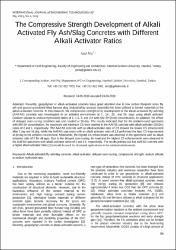The Compressive Strength Development of Alkali Activated Fly Ash/Slag Concretes with Different Alkali Activator Ratios
Özet
Recently, geopolymer or alkali-activated concrete takes great attention due to low carbon footprint since fly ash and ground granulated blast furnace slag (industrial by-product materials) has been utilized as binder materials in the alkali-activated concrete. In this research, the compressive strength (CS) development of the alkali-activated fly ash/slag (AAFAS) concrete was investigated in an ambient environment at 7., 14., 28., and 56. days using alkali activator (sodium silicate to sodium hydroxide) ratios of 1, 1.5, 2, and 2.5 with 6M SH (low) concentration. In addition, the effect of delayed oven-curing condition was also studied at 56.day. The results indicated that for the ambient-cured specimens with 6M SH concentration, the maximum and minimum CS were reached in the AAFSS concrete with alkali activator (SS/SH) ratios of 2 and 1, respectively. The AAFAS concrete with an alkali activator ratio of 2.5 showed the lowest CS enhancement after 7.day and 14.day, while the AAFAS specimens with an alkali activator ratio of 1.5 performed the least CS improvement at 28.day in the ambient environment. Meanwhile, the highest CS enhancement was observed in the specimens with an alkali activator ratio of 2 for all ages. Due to the delayed oven-curing, the least and the highest CS enhancements were observed in the AAFAS specimens with alkali activator ratios of 2 and 1.5, respectively. The results pointed out that AAFAS concrete with a higher alkali activator ratio (≥2) should be used for structural applications in the ambient environment.
Cilt
5Sayı
2Bağlantı
https://hdl.handle.net/11363/1395Koleksiyonlar
Aşağıdaki lisans dosyası bu öğe ile ilişkilidir:


















